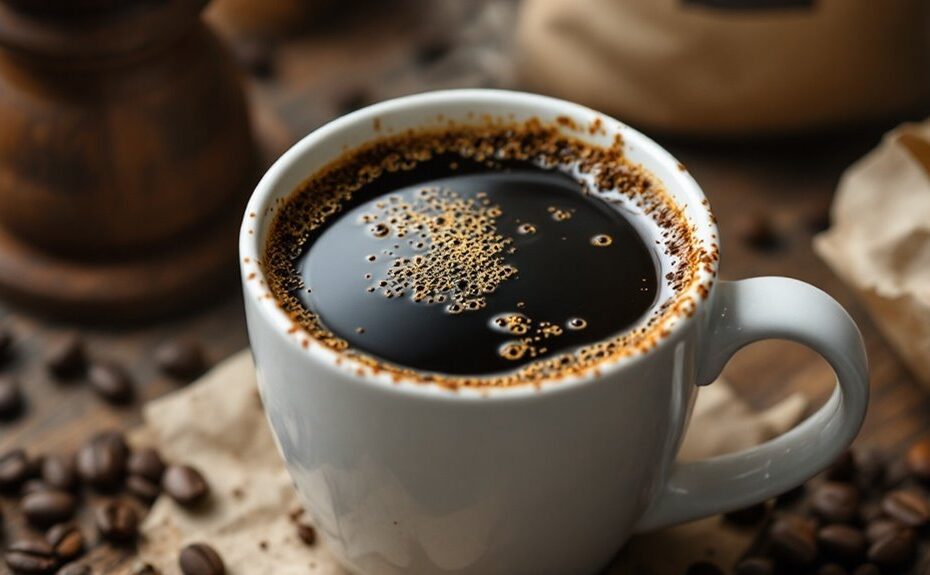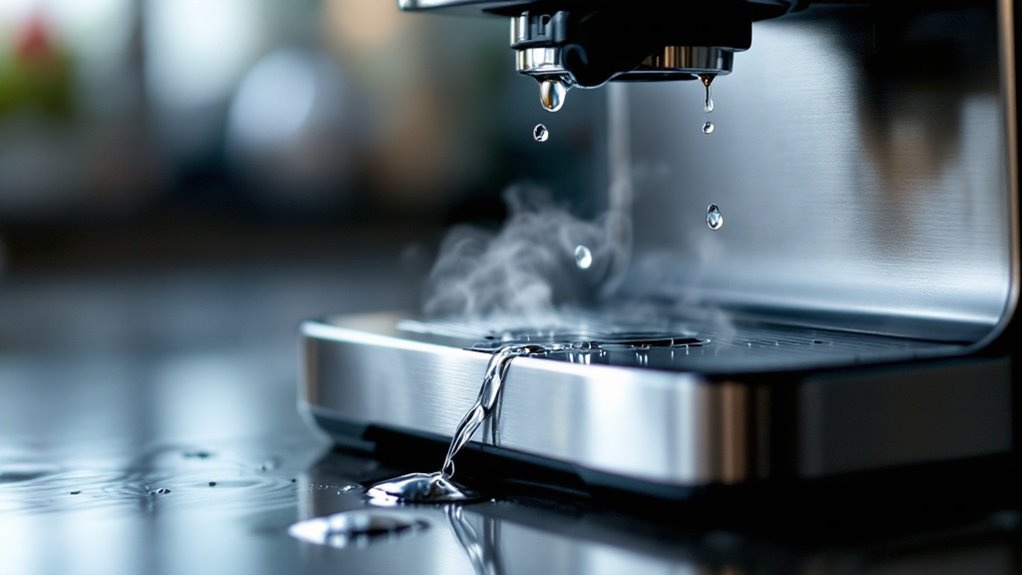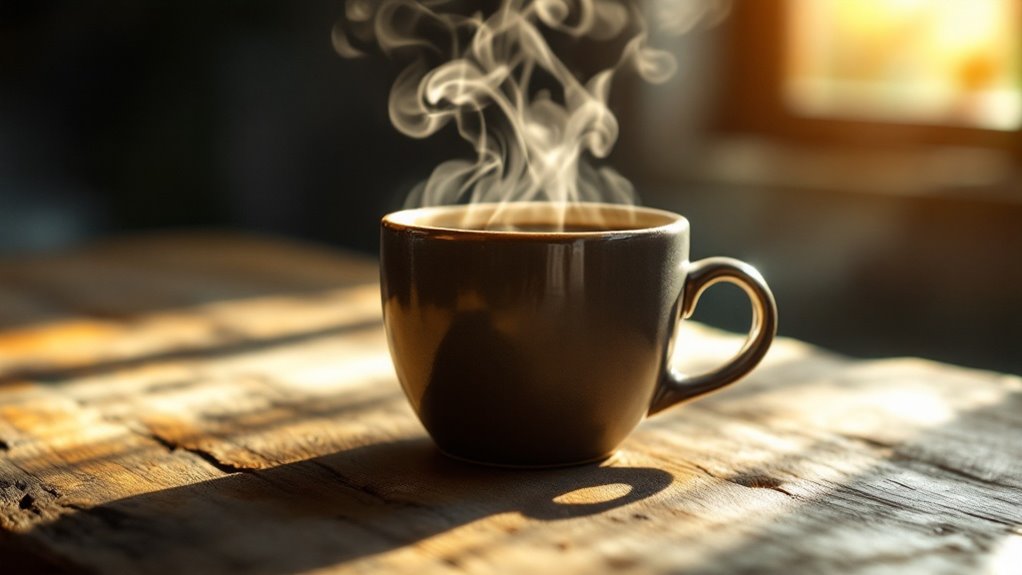







You've brewed your coffee, but the bitterness hits you first, masking the flavors you were hoping to enjoy. It's frustrating, but the cause might be simpler than you think. Over-extraction, water that's too hot, or even the grind size can turn your cup into a bitter experience. Dark roasts and stale beans don't help either. The good news? You can fix it. Adjusting your brewing time, tweaking the grind, or controlling the water temperature might be all it takes. But there's more to it—understanding these factors could transform your coffee routine. What's your next step?
Key Takeaways
- Over-extraction from prolonged brewing time or fine grind size extracts bitter compounds like tannins and caffeine.
- High water temperature above 205°F scorches coffee, intensifying bitterness.
- Dark roast or over-roasted beans develop burnt, bitter flavors due to prolonged roasting.
- Poor-quality beans, such as Robusta or stale Arabica, contain higher levels of bitter compounds.
- Incorrect coffee-to-water ratio or over-steeping leads to imbalanced extraction and increased bitterness.
Common Causes of Bitter Coffee
Bitter coffee often stems from over-extraction, where water interacts with coffee grounds for too long, pulling out excessive bitter compounds. Over-extraction occurs when the brewing process extends beyond the ideal time, allowing water to dissolve undesirable flavors from the grounds. Water temperature also plays a critical role; if it exceeds 205°F, it can scorch the coffee, intensifying bitterness. Grind size is another factor—finely ground coffee increases surface area, accelerating extraction and often leading to over-extraction if not carefully managed. Dark roast beans, while popular for their bold flavor, are more prone to bitterness due to prolonged roasting, which can create a burnt taste. Poor-quality beans, such as robusta or low-grade arabica, inherently contain higher levels of bitter-tasting compounds like caffeine and chlorogenic acid. These compounds are more pronounced when brewed, especially if combined with suboptimal brewing techniques. By understanding these factors—over-extraction, water temperature, grind size, dark roast, and poor-quality beans—you can better identify the root causes of bitter coffee and take steps to avoid them.
How to Fix Bitter Coffee
To fix bitter coffee, adjust your brewing time to avoid over-extraction; for example, press a French press filter sooner or pour water faster in pour-over methods. Modify your grind size by using coarser grounds, which slows extraction and reduces bitterness, ensuring it aligns with your brewing technique. These adjustments help balance flavor and prevent the release of bitter compounds.
Adjust Brewing Time
Adjusting your brewing time is one of the most effective ways to combat bitterness in your coffee. The brew time directly influences the extraction process, and over-extraction is a primary cause of bitter flavors. When you brew coffee for too long, compounds like tannins and caffeine are over-extracted, leading to a harsh, bitter taste. For French press, limit your brew time to 3-4 minutes to prevent over-extraction and maintain balance. With pour-over methods, aim for a total brew time of 2.5-3.5 minutes; exceeding this range can release bitter compounds. For espresso, use a timer to guarantee shots pull within 25-35 seconds, as longer extraction times intensify bitterness. Cold brew requires a steeping time of 12-16 hours; extending this period risks extracting overly bitter flavors. If you're using a drip coffee machine, adjust it to brew for 5-6 minutes, as prolonged brewing extracts undesirable bitter elements. By carefully controlling your brew time, you can minimize bitterness in coffee and achieve a smoother, more enjoyable cup. Precision in timing is key to balancing extraction and avoiding the bitter flavors that come from over-brewing.
Modify Grind Size
Modifying your grind size is a critical step in controlling extraction and reducing bitterness in your coffee. If your coffee tastes bitter, it's often due to over-extraction caused by a grind size that's too fine. Finely ground coffee exposes more surface area to water, accelerating extraction and pulling out bitter compounds. To fix this, adjust your grinder to a coarser setting. For French Press Coffee, always use a coarse grind to match the longer steeping time, preventing over-extraction and ensuring a smoother cup. If you're using a drip coffee maker, aim for a medium grind size, which balances extraction and minimizes bitterness. When adjusting your grind size, make incremental changes and test the results. A single notch on your grinder can greatly impact the flavor profile of your coffee. Remember, the goal is to achieve ideal extraction—too coarse, and your coffee will taste weak; too fine, and it'll turn bitter. Experiment with your grind size to find the sweet spot for your brewing method and enjoy a balanced, flavorful cup.
Understanding the Role of Bitterness
Bitterness is a natural component of coffee, detected primarily at the back and center of your tongue. When balanced, it enhances flavor profiles, adding depth with notes like dark chocolate or grapefruit. However, excessive bitterness can overwhelm desirable flavors, so understanding its role helps you appreciate or mitigate it effectively.
Natural Bitterness in Coffee
Coffee often contains a natural bitterness that's influenced by compounds like caffeine and chlorogenic acid, which vary depending on the bean type and roast level. These compounds interact with your taste buds, creating the bitter notes you perceive in your cup. Specialty coffee, in particular, balances this bitterness with other flavors, such as dark chocolate or cocoa, to create a complex and rich taste profile. The type of coffee beans you use plays a significant role in determining the level of bitterness. For example, Robusta beans contain nearly double the caffeine of Arabica beans, resulting in a more pronounced bitter taste. Arabica beans, on the other hand, tend to offer a smoother, less bitter experience. Roast level also impacts bitterness; darker roasts amplify bitter compounds, while lighter roasts preserve more acidity and sweetness. A small amount of bitterness is desirable in high-quality coffee, as it adds depth and complexity. However, your preference for bitterness may vary, depending on how your taste buds respond to these compounds. Understanding this natural bitterness helps you appreciate the nuances in your coffee.
Bitterness Enhances Flavor Profiles
A subtle touch of bitterness can elevate your coffee's flavor profile, adding layers of depth and complexity that make each sip more intriguing. When tasting coffee, you'll notice that bitterness acts as a counterpoint to brighter, acidic notes, creating a balanced sweet and savory experience. A skilled coffee roaster carefully develops this balance, ensuring that bitterness enhances rather than overwhelms the tasting notes. For example, a hint of bitterness can highlight flavors like dark chocolate, licorice, or spices, making the cup more dynamic and satisfying. This interplay between bitterness and other flavor elements is what transforms a simple brew into a nuanced sensory experience. Specialty-grade coffees often showcase this balance, where bitterness complements the natural sweetness and acidity, resulting in a harmonious flavor profile. By understanding how bitterness interacts with other components, you can better appreciate its role in crafting a well-rounded cup. When balanced correctly, bitterness doesn't dominate; instead, it amplifies the aromatic and flavor characteristics, making your coffee more memorable and enjoyable.
Balancing Bitterness for Taste
How can you guarantee that bitterness enhances rather than detracts from your coffee's flavor? Bitterness is a natural component of coffee, but achieving the right balance secures it complements rather than overwhelms the flavor profile. To balance bitterness, you must control brewing variables. Start by adjusting your grind size; a finer grind increases extraction, potentially amplifying bitterness, while a coarser grind reduces it. Water temperature also plays a critical role—too hot, and you risk over-extraction, leading to excessive bitterness. Aim for a range between 195°F and 205°F for ideal extraction. Brew time is equally important; longer contact between water and coffee grounds extracts more bitter compounds, so monitor your brewing duration carefully. Specialty-grade coffee often contains subtle bitter notes, like dark chocolate or cocoa, which enhance complexity when balanced correctly. Experiment with these variables to tailor the bitterness to your taste preferences. Remember, a small amount of bitterness can elevate your coffee's flavor, but over-extraction or poor brewing techniques can make it unpalatable. By mastering these adjustments, you'll achieve a harmonious balance that highlights your coffee's unique characteristics.
Factors Affecting Coffee Flavor
Several key factors influence the flavor of your coffee, with bitterness often arising from imbalances in these elements. The grind size of your coffee grounds plays a critical role; finer grinds increase surface area, accelerating extraction. If paired with excessive brewing time, this can over-extract bitter compounds. Conversely, coarse grinds may under-extract, leaving your coffee weak and unbalanced. Water temperature is equally essential; aim for 195°F to 205°F. Temperatures above 205°F over-extract bitter flavors, while cooler water fails to extract enough, resulting in a flat taste. Brewing time must align with your method—espresso requires seconds, while French press needs minutes. Over-steeping, even with ideal water temperature, can intensify bitterness. Water quality also impacts flavor; hard water with high mineral content or impurities can amplify bitter notes. Use filtered or soft water to guarantee a clean, balanced brew. By carefully managing these variables—grind size, water temperature, brewing time, and water quality—you can minimize bitter flavors and achieve a harmonious cup of coffee.
Choosing the Right Coffee Beans
Selecting the right coffee beans is a critical step in crafting a balanced, flavorful cup and avoiding unwanted bitterness. Start by choosing specialty-grade Arabica beans, which contain less caffeine and chlorogenic acid compared to Robusta beans, reducing the likelihood of a bitter taste. Opt for light or medium roasts, as dark or over-roasted beans often develop burnt, bitter flavors that overpower the coffee's natural profile. Single-origin beans from regions like Central America, South America, or East Africa typically offer balanced and complex flavor notes, enhancing your coffee experience. Always confirm your beans are freshly roasted, ideally within 1-2 weeks of purchase, to preserve their peak flavor and prevent stale, bitter undertones. Avoid low-quality or mass-produced beans, as these are frequently over-roasted to mask defects, resulting in a harsh, bitter taste. By prioritizing high-quality, freshly roasted beans and selecting the right roast level, you'll greatly reduce bitterness and reveal the full potential of your coffee's flavor.
Brewing Techniques to Avoid Bitterness
Mastering brewing techniques is essential to crafting a smooth, balanced cup of coffee and minimizing bitterness. Start by using filtered water to guarantee impurities don't affect the flavor. Hot water should be between 195°F and 205°F; too hot, and it'll over-extract bitter compounds. Adjust your grind size—coarser grinds work best for methods like French press or pour-over, as they slow extraction and reduce bitterness. When you brew, shorten the contact time by pressing the French press filter earlier or pouring water faster in pour-over methods. This prevents over-extraction, which can make your cup taste harsh. Use the right coffee-to-water ratio: 1-1.5 tablespoons of grounds per 6 ounces of water for drip machines, or 1.5-2 tablespoons for French press. This balance secures strength without overwhelming bitterness. Finally, clean your brewing equipment regularly. Residual oils and old grounds can impart stale, bitter flavors to your coffee. By controlling these variables—water temperature, grind size, brew time, and equipment cleanliness—you'll make a consistently smooth, enjoyable cup every time.
Disclosure: As an Amazon Associate, I earn from qualifying purchases.






